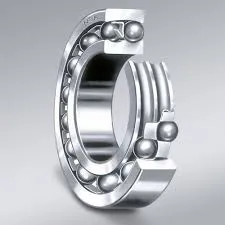
Oct . 12, 2024 23:05 Back to list
Understanding Double Row Spherical Roller Bearings and Their Applications in Machinery
Understanding Double Row Spherical Roller Bearings
Double row spherical roller bearings are essential components widely used in various industries, particularly in heavy machinery, automotive, and construction applications. These bearings are designed to accommodate both radial and axial loads, making them ideal for applications with challenging operational conditions. This article delves into the features, advantages, applications, and maintenance considerations of double row spherical roller bearings.
Design Features
Double row spherical roller bearings consist of two rows of spherical rollers and a common spherical outer raceway. This design allows for a self-aligning capability, which enables the bearings to accommodate misalignment due to shaft deflection or mounting errors. The rollers are typically equipped with a cage that maintains spacing, reducing friction and wear during operation.
The inner race of the bearing usually contains two sets of rolling elements, which enhances the load-carrying capacity compared to single-row bearings. This makes double row spherical roller bearings suitable for heavy-duty applications. The spherical shape of the rollers allows for a greater contact area with the raceways, distributing loads more evenly and relieving stress on individual parts.
Advantages
One of the primary advantages of double row spherical roller bearings is their ability to handle both axial and radial loads. In applications where equipment is subject to high shock loads and vibrations, these bearings provide increased reliability due to their enhanced structural integrity. Their self-aligning feature is particularly beneficial for reducing the risk of premature bearing failure, as it compensates for misalignment and reduces the risk of uneven wear.
Moreover, double row spherical roller bearings offer excellent performance in high-temperature environments, thanks to the availability of specialized materials and lubrication options. This capability is vital in industries such as mining and cement, where operating conditions can be severe.
Another significant advantage is their longevity. With proper maintenance and lubrication, these bearings can have a long service life, reducing the frequency of replacements and associated downtime, which translates to cost savings for businesses.
Applications
double row spherical roller bearing

Double row spherical roller bearings are utilized in various sectors, including
1. Mining and Mineral Processing Due to their capacity to withstand heavy loads and harsh environments, these bearings are prevalent in equipment such as crushers and conveyor belts.
2. Construction Equipment Heavy machinery like excavators, bulldozers, and loaders utilizes these bearings for their durability and reliability under extreme conditions.
3. Power Generation Spherical roller bearings are commonly used in wind turbines and other power generation equipment, where they endure significant radial and axial loads.
4. Marine Applications Their endurance against corrosive environments makes them suitable for applications in ships and offshore platforms.
5. Automotive Industry These bearings are used in various vehicle components, including axles and differential gears, where robust performance is essential.
Maintenance Considerations
To maximize the lifespan of double row spherical roller bearings, regular maintenance is critical. This includes proper lubrication to minimize wear and heat generation. The choice of lubricant—whether grease or oil—depends on the operating conditions, such as temperature and speed.
Regularly inspecting for signs of wear, misalignment, and contamination can help prevent failure. This involves monitoring operational temperatures and vibrations, which can indicate potential issues within the bearing or associated machinery.
In conclusion, double row spherical roller bearings play a crucial role in ensuring the smooth operation of heavy machinery and various industrial applications. Their unique design, ability to handle diverse loads, and self-aligning features make them a superior choice for demanding environments. By understanding their advantages and ensuring proper maintenance, industries can significantly enhance their equipment's reliability and performance.
Latest news
-
Grooved Ball Bearing Design and Functionality
NewsJun.04,2025
-
Concrete Mixer Bearing Load Capacity Testing
NewsJun.04,2025
-
6004 Bearing Dimensions in Robotic Joint Designs
NewsJun.04,2025
-
Advantages of Single-Row Deep Groove Ball Bearings
NewsJun.04,2025
-
Applications of Deep Groove Ball Bearings in Automotive Systems
NewsJun.04,2025
-
Innovations in Bearing Pressing Machine Design
NewsJun.04,2025
